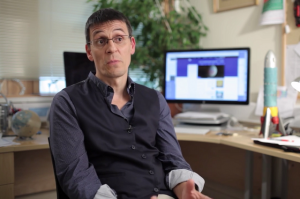Exoplanets
Astrophysicist Didier Queloz on the how to find exoplanets, their impact on astronomy, and the uniqueness of o...
The video is a part of the project British Scientists produced in collaboration between Serious Science and the British Council.

Metamaterials is the science of materials that do not occur in nature, that we can fabricate it in our laboratories and enable us to do interesting and unusual things with light. It’s a relatively new science, although it was proposed theoretically in the 60s. It’s only in the last decade or so that we’re able to fabricate metamaterials in the laboratory.
They’ve led to some extremely interesting and unusual applications including the celebrated optical cloak, for example. And even lenses that are sometimes perfect or actually behave much better than conventional lenses. Moreover, we are able to look at lenses that have different and unusual properties, such as being very-very thin and being able to direct light in ways that are not possible using conventional materials.
The general theme of being able to create materials that can manipulate light in ways that really haven’t been possible previously, and certainly it’s opened up a whole new area of science, optical science. And indeed beyond optical science. Metamaterials are influencing other areas of physics such as acoustics and thermal physics.
One of the major instigators of the field of metamaterials was Victor Veselago, Russian scientist, who in the 60’s proposed some very interesting ideas that were simply beyond technology at that time. But there were very visionary ideas. He proposed some concepts related to how light interacts with matter.
If you think of light as electromagnetic radiation, there are two parts to the wave that forms the electromagnetic field. There’s an electric part and there is a magnetic part. In terms of the optics that we’re familiar with in everyday life, it’s how the electric field interacts with the material that is important, and that’s what determines the colors and how much things reflect and that kind of things that we’re familiar with in everyday life.
However, what Victor Veselago did was to examine beyond the electrical response of a material. What would happen if we had some control over the magnetic response at the same time? There are two parts of the wave: there is an electric part and there is a magnetic part. He examined what would happen if we had control not just over this everyday electrical response but also, perhaps in some future way, we would have control over the magnetic response.
Because he was quite visionary, he proposed that the numbers that are associated with the electrical response and the magnetic response, could take any value whatsoever. So we start with the everyday response, electrical response that has a positive value. But he suggested it could have a negative value, not just in the electrical component but also in the magnetic component.
This idea that the force, or in this case the electric field and the magnetic field that make up light, can produce a response in a material, that is opposite to the direction in which those fields are acting. It is quite crucial to the science of metamaterials that we can produce responses that simply don’t occur naturally.
What we discovered later on was that it was possible to create these responses using artificial media, in which we take a material and we include very small metallic structures. They behave in the manner of a resonance as much as my mass on the spring. So they were actually able to produce that kind of negative response. In terms of how light sees such structures, it’s always the case that the wavelength, the distance between the crests of the waves, is always very much greater than the tiny structures that we make inside metamaterials. And just as a natural material is determined by the chemistry or the atoms and how the electrons move, our artificial media or metamedia, metamaterials are determined by these very small subwavelength inclusions that we are able to create.
In Victor Veselago’s development of the subject, he examined what happened if we had a negative electrical response and a negative magnetic response. He was able to relate the simultaneously negative properties to what was effectively a negative refractive index.
We’re familiar in everyday life with the idea of light bending and refracting through media. When we were at school, we learn about how light refracts as it passes, for example, from air to glass. We characterize that bending with a quantity called the refractive index of the glass.
What Victor Veselago explored was the possibility, as a result of these negative parameters, that the refractive index is negative, and, actually, that the bending of light is extreme, so that when light enters a material made with these simultaneously negative properties, it bends not just a little bit, but actually bends drastically, it’s so-called negative refraction. He proposed a number of other phenomena that would be associated with materials with these properties. But that was the most significant one.
This idea was taken up here, at Imperial College, by Professor Sir John Pendry in the physics department. He published an extremely influential paper that examined how material that has this negative property and negative refractive index could be formed up into a lens. Actually it is a very simple idea. A slab of this material could refract light very simply and very naturally to form a lens. But it was the lens that had extraordinary properties at least in theory. It was a lens that could take the object and exactly reproduce it in the image. A so-called perfect lens was free of any of the distortions or aberrations that we associate with conventional lenses, such as the lenses that my glasses are made out of.
In fact, some of the ideas that were originally proposed to make a perfect lens were actually implemented in the laboratory, not absolutely perfectly, but beyond the limits that we thought were conventionally applicable. So we have this interesting situation, where the theory shows that something can be done perfectly, which is something that was unexpected for us as for theoretical physicists. It moves the challenge for the experimentalists and the technologists to actually implement and reached that goal. It makes our possibility to make something perfect a matter of technology, a matter of bucks rather than a matter of principle.
Following these groundbreaking ideas the whole field of metamaterials has exploded and has given rise to many different possible directions. We’re now looking at being able to make very small antennas that make what we call metasurfaces that can direct light in very interesting and novel ways. This, for example, could be used in satellite communications, could also be used to improve the lenses in our mobile phones and this kind of technology has also given rise to some very intriguing possibilities, in terms of bending light for actually cloaking objects or making them invisible or even actually hiding events in time. So there are many directions that are being pursued at present.

Astrophysicist Didier Queloz on the how to find exoplanets, their impact on astronomy, and the uniqueness of o...

Historian and Philosopher of Science Liba Taub on a history of the globe, antique representation of the Univer...

Glaciologist Martin Siegert on the history of glacial theory, lake Vostok research and what ice tells us about...